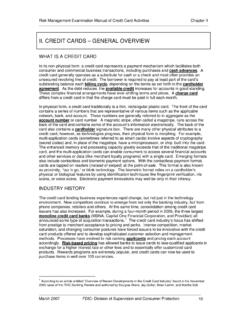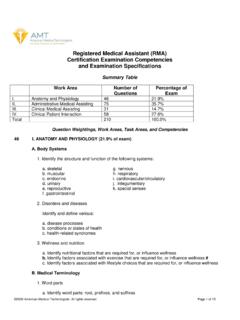Transcription of REGULATORY REFORM AND INNOVATION - OECD
1 REGULATORY REFORM ANDINNOVATIONORGANISATION FOR ECONOMIC CO-OPERATION AND DEVELOPMENT23 FOREWORDG overnment regulations can have both positive and negative effects on theinnovation process. Among other goals, REGULATORY REFORM in the OECD countries is intended to enhance the positive REGULATORY effects on should help ensure that regulations in all spheres of activity are fullyresponsive to changes in the economic, social and technical conditionssurrounding them. The REGULATORY process must take into account the effects ofregulation on INNOVATION as well as the implications of technical change for therationale and design of regulation. The regulation/ INNOVATION interface is mutualand dynamic; an understanding of this interface is crucial to REGULATORY OECD Directorate for Science, Technology and Industry (DSTI) iscurrently exploring the diverse and complicated links between regulation andinnovation.
2 Regulation and REGULATORY REFORM can affect technologicaldevelopment in sectors ranging from biotechnology to banking, and caninfluence the INNOVATION process from research through technology report presents an overview of the relationship between regulatoryreform and INNOVATION . It is an interim report which presents some preliminaryfindings of ongoing DSTI research in this area. This work will contribute to theOECD horizontal programme on REGULATORY REFORM and to the work programmeof the Committee for Scientific and Technological Policy (CSTP).45 TABLE OF 9A. Types of Regulations .. 10B. REGULATORY Effects on INNOVATION .. 12C. Technology Effects on Regulation .. 14 ECONOMIC REGULATION AND 16A. Competition Law .. 16B. Regulated Industries .. 18C. Financial Markets .. 20 SOCIAL REGULATION AND 22A. Environment .. 22B. Safety and 24C. Labour 26 ADMINISTRATIVE REGULATION AND 28A.
3 Business Operations .. 28B. Retail Distribution .. 30C. Intellectual 3467 SUMMARYR egulation directly affects the innovative process, while INNOVATION andtechnical change have significant impacts on regulation. To be successful, REGULATORY REFORM efforts must take into account the linkages between regulationand INNOVATION . A three-fold typology of regulation is used here for illustrativepurposes. Economic regulation is intended to improve the efficiency ofmarkets in delivering goods and services which influences the innovativeprocess. Social regulation protects the environment and the safety and health ofsociety at large its design can encourage or discourage regulation governs the practical functioning of the public andprivate sectors setting some basic conditions for technological REFORM is directed to making sure that these regulations arefully responsive to changes in the economic, social and technical conditionssurrounding them.
4 Many reforms are stimulated by technology developmentswhich have changed the underlying cost and competitive structure in industriesranging from telecommunications to banking to biotechnology. At the sametime, REGULATORY REFORM is a powerful stimulus to further reforms in both the manufacturing and service sectorshave been essential to the development and diffusion of new technologies, suchas the Internet, automatic teller machines and optical scanners in redesign of approaches to environmental, safety and health regulation hasincreased the flexibility of firms in developing innovative solutions to socialproblems with an emphasis on prevention rather than mere control. Thestreamlining of administrative regulations has reduced the cumulative burden onbusiness, freeing up resources for research and technology development. But asthese reforms have unleashed a new round of technical change, unforeseen side-effects and different technology impacts have emerged to again underline theneed for REGULATORY review of the regulation/ INNOVATION interface leads to several generalconclusions on how to improve the positive REGULATORY effects on innovationwithout jeopardising the original REGULATORY objectives: Understand regulation/technology linkages.
5 The REGULATORY process whether in the economic, social or administrative spheres must be evervigilant to the effects of technical change. Introduce competition. In all economic sectors, a certain degree ofcompetition among firms is essential to the innovative process. Streamline regulations. In the interest of economic efficiency andinnovation, REGULATORY REFORM should seek to remove duplicative, onerousand inefficient regulations, particularly to aid small and medium-sizedenterprises. Use technology-driving approaches. Maximum use should be made ofregulatory approaches or alternatives which are technology-friendly, suchas economic instruments, voluntary agreements and performance ratherthan design standards. Harmonize internationally. Countries should pursue greatercompatibility among their regulations to remove uncertainties,inefficiencies and market barriers which can slow TYPES OF REGULATIONSR egulation can be said to generally refer to policies where the governmentacts as a referee to oversee market activity and the behaviour of private actors inthe economy.
6 Such government intervention in the marketplace is usuallyjustified on the basis of market failures and the need to ensure societal well-being. For illustrative purposes, this report discusses three general types ofregulation, all of which have effects on INNOVATION (see Box 1). Economicregulation is intended to ensure the efficiency of markets, partly throughpromoting adequate competition among actors in the market-place. Socialregulation is intended to promote the internalisation of all relevant costs bythese actors. Administrative regulation can be said to aim at ensuring thesmooth functioning of public- and private-sector REFORM is directed to making sure that these regulations remainfully responsive to changes in the economic, social and technical conditionssurrounding them. REGULATORY REFORM can take many forms. With regard toeconomic regulation, REFORM can mean deregulation, privatisation or opening upa market to increased competition.
7 In the case of social regulation, reformgenerally means improving the flexibility and cost-effectiveness of regard to administrative regulation, REFORM is usually directed tostreamlining and improving the efficiency of regulations. In some cases, REGULATORY REFORM can mean increased rather than decreased levels of regulationor government all domains, REGULATORY REFORM should yield benefits in terms of reducingcosts, enhancing efficiency and stimulating INNOVATION . However, this must bedone without sacrificing or jeopardising the original REGULATORY objectives whether this be ensuring fair market transactions, protecting the environment ormaintaining government oversight of private sector activities. Regulatoryreform often incurs some short-term costs of adjustment; thus, the assessmentof overall effects must take a long-term view. REGULATORY REFORM is alsocontroversial in re-distributing the costs of public policies among economicactors and altering established systems of protection, whether for industry orconsumers.
8 Establishing the right degree and form of regulation is a difficultchallenge for governments and has important implications for the processes ofinnovation and technological 1 TYPES OF REGULATIONSE conomic regulation Economic regulation is generally intended to improvethe efficiency of markets in delivering goods and services. It can includegovernment-imposed restrictions on firm decisions over prices, quantity,service and entry and regulation Social regulation is intended to protect the well-being andrights of society at large. It can include protection of the environment, healthand safety in the workplace, protection of the rights of workers, and protectionof buyers from fraudulent or incompetent behaviour by regulation Administrative regulation relates to generalgovernment management of the operation of the public and private sectors. Itcan include regulations relating to taxes, business operations, distributionsystems, health care administration and intellectual property REGULATORY EFFECTS ON INNOVATIONR egulations have numerous types of effects on INNOVATION , both positiveand negative.
9 In the economic sphere, regulations can maintain a certain levelof openness or competition in product markets which provides the necessaryconditions for research and INNOVATION . In the social sphere, regulations canplace technical demands on industries and act as focusing devices for theirresearch efforts. Regulations have also spawned the creation of new industriesand products as in the case of the environment industry (OECD, 1996c).Administrative regulation ensures there are fair ground rules for all economicactors in the innovative process, as in the case of intellectual property , regulations can also erect barriers to the development of new,improved products and production processes. They can encourage or discourageresearch efforts by firms. They can distort the choice of technologies that areexplored and adopted. They can create barriers to INNOVATION by increasing theuncertainty and costs of the development process.
10 And they can affecttechnology diffusion (see Box 2). A 1994 survey by the Union of Industrial andEmployers' Confederations of Europe of more than 2 500 European companiesasked them to assess whether regulations made it easier or more difficult torealise six of the principal determinants of successful INNOVATION . According tothe companies surveyed, regulations make it more difficult (or much moredifficult) for companies to: i) minimise costs (75 per cent of companiessurveyed); ii) organise in a flexible way (59 per cent); iii) reduce time tomarket (54 per cent); and iv) reduce uncertainty (49 per cent) (UNICE, 1995). REGULATORY REFORM is intended to address the deficiencies in regulation whichnegatively affect the innovative process from research to diffusion, while stillachieving the benefits of 2 REGULATION AND TECHNOLOGY DIFFUSIONThe effects of insufficient competition in impeding technology diffusion isvisible in the telecommunications sector, which remains under monopolycontrol in many countries.















